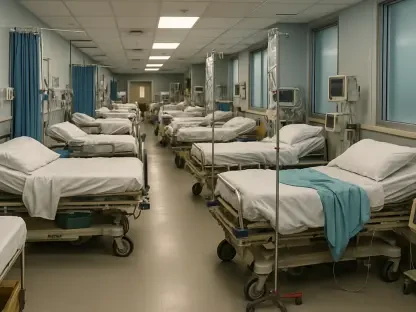In the heart of Maryland, local health departments (LHDs) are grappling with a funding system that seems stuck in a bygone era, unable to keep pace with the pressing demands of modern public health challenges, while counties across the state sound the alarm over a structure lacking transparency and predictability. This outdated model not only hampers effective budget planning but also threatens the ability of LHDs to deliver critical services tailored to community needs. As local governments voice their concerns through organizations like the Maryland Association of Counties (MACo), the urgency for a reformed funding framework has never been clearer. The stakes are high, with the health and well-being of residents hanging in the balance, prompting a deeper examination of the systemic flaws and the path forward.
Unpacking the Current Funding Challenges
Systemic Flaws in the Existing Model
The funding mechanism for Maryland’s LHDs, a joint effort between state and county governments, is rooted in a formula that has remained largely unchanged for decades. This outdated structure fails to account for the complexities of contemporary public health demands, such as emerging diseases, new mandates, and rising operational costs. A significant issue lies in the lack of transparency around how local matching contributions are calculated, often leaving counties blindsided by sudden increases. For instance, in recent years, several counties faced unexpected hikes in required contributions due to state employee salary adjustments that were not factored into the core funding formula. These financial surprises, frequently communicated after local budgets were finalized, have created strain and necessitated temporary waivers as a short-term solution rather than a sustainable fix. The result is a system that fosters uncertainty and undermines trust between state and local partners.
Impact on Local Budget Planning
Beyond the lack of clarity, the unpredictability of the current funding model poses a severe challenge to responsible fiscal management at the county level. Local governments rely on stable projections to allocate resources effectively, yet the existing framework often disrupts this process with last-minute adjustments. This unpredictability makes it difficult for counties to prioritize public health initiatives or plan for long-term investments in infrastructure and personnel. The ripple effects are felt in the diminished capacity of LHDs to address community-specific needs, from combating chronic diseases to preparing for public health emergencies. Counties are left in a reactive mode, constantly adjusting to unforeseen costs rather than proactively building resilient health systems. The frustration is palpable, as local leaders advocate for a funding approach that aligns with the realities of modern governance and supports strategic planning without the burden of fiscal ambiguity.
Pathways to a Modernized Funding Framework
Building Transparency and Predictability
A critical step toward reforming Maryland’s public health funding lies in establishing a system that prioritizes transparency and predictability for local governments. MACo has been vocal in urging the Maryland Commission on Public Health to revise the core funding formula, ensuring that calculations for local contributions are clearly communicated well in advance of budget cycles. Such clarity would enable counties to anticipate financial obligations and integrate them into their planning processes without the fear of sudden disruptions. Moreover, a modernized formula should account for inflation, population growth, and evolving health challenges, creating a more equitable distribution of responsibilities between state and local entities. This shift would foster a stronger partnership, allowing LHDs to focus on delivering essential services rather than navigating fiscal uncertainties. The push for these changes reflects a broader consensus on the need for a reliable funding model that supports both current operations and future preparedness.
Engaging Stakeholders for Sustainable Solutions
Collaboration between state officials, county leaders, and public health experts is essential to crafting a funding framework that stands the test of time. Events like the MACo Summer Conference, with sessions dedicated to exploring how LHDs manage limited budgets and advocate for modernization, provide a vital platform for dialogue. These discussions highlight the importance of balancing state and local responsibilities while addressing the unique needs of diverse communities across Maryland. Stakeholders emphasize that a sustainable solution must go beyond temporary fixes, incorporating mechanisms to handle unexpected cost increases without placing undue burden on counties. By fostering ongoing engagement, as seen in the commitment of counties to work with the Commission on finalizing recommendations, there is an opportunity to build a funding model that not only resolves current shortcomings but also anticipates future public health demands. This collective effort underscores the shared goal of ensuring that LHDs are adequately resourced to protect and promote community well-being.
Reflecting on Steps Taken for Reform
Lessons from Past Struggles
Looking back, the journey to address Maryland’s public health funding issues revealed deep-seated frustrations with an opaque and outdated system that often left local governments in a precarious financial position. The unexpected contribution hikes faced by counties in recent times stood as stark reminders of the flaws in the existing model, where last-minute adjustments disrupted carefully planned budgets. Temporary waivers offered fleeting relief but failed to tackle the root causes of fiscal uncertainty. Through feedback provided by MACo, counties articulated a unified demand for clarity and predictability, shedding light on how the lack of a modern formula hindered the ability of LHDs to meet evolving community needs. These past challenges served as a catalyst, galvanizing local leaders to push for meaningful change in how public health funding was structured and communicated.
Moving Forward with Actionable Change
Reflecting on those struggles, it became evident that the path ahead required actionable reforms to ensure a robust public health system. A revised funding formula, grounded in transparency and tailored to contemporary demands, emerged as a cornerstone for progress. Strengthening state-county coordination through regular dialogue and clear guidelines promised to rebuild trust and enhance planning capabilities. Additionally, investing in platforms for stakeholder engagement, such as conferences and working groups, offered a way to sustain momentum and address emerging issues collaboratively. As Maryland moved forward, the commitment to a fair and functional funding model remained a guiding principle, ensuring that local health departments could deliver critical services without the shadow of fiscal unpredictability. This focus on practical solutions marked a hopeful step toward safeguarding the health of communities across the state for years to come.









